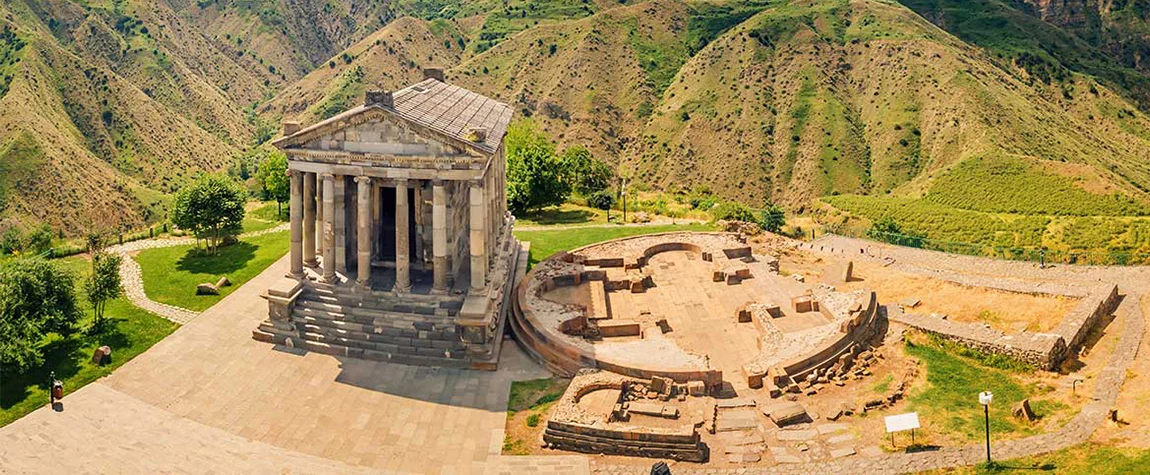Armenia, often called an open-air museum, is a land steeped in history, where ancient wonders blend seamlessly with breathtaking landscapes. As the first nation to adopt Christianity as its official religion in 301 AD, Armenia boasts some of the oldest churches and monasteries in the world. Beyond its religious heritage, the country is home to prehistoric sites, ancient fortresses, and unique cultural landmarks that offer a glimpse into the past. Whether you’re a history enthusiast or a curious traveler, Armenia’s oldest monuments promise an unforgettable journey through time.
For those looking to document their travels in an engaging way, using an animation maker can enhance storytelling, bringing the history of these ancient wonders to life.
Zorats Karer: Armenia’s Stonehenge
Zorats Karer, also known as Karahunj, is one of Armenia’s most enigmatic sites. Located in the Syunik Province, this prehistoric structure consists of over 200 standing stones, some with circular holes carved into them. Archaeologists and researchers debate its purpose—some believe it served as an ancient observatory, while others see it as a necropolis. Regardless of its true function, Zorats Karer remains one of the most fascinating landmarks in Armenia, offering a glimpse into the advanced astronomical knowledge of its early inhabitants.
Erebuni Fortress: The Birthplace of Yerevan
Founded in 782 BC by King Argishti I of Urartu, Erebuni Fortress marks the origins of Armenia’s modern capital, Yerevan. The remnants of the fortress sit atop Arin Berd Hill, providing panoramic views of the city. The site features well-preserved cuneiform inscriptions detailing its foundation, as well as remnants of ancient murals and pottery. Visiting Erebuni Museum, located at the base of the fortress, allows travelers to explore artifacts that tell the story of Yerevan’s early days and its connection to the powerful Urartian kingdom.
Garni Temple: A Pagan Marvel in a Christian Nation
Unlike most of Armenia’s historical sites, which are rooted in Christianity, Garni Temple stands as a rare pre-Christian relic. Built in the 1st century AD, this Greco-Roman-style temple is dedicated to Mihr, the god of the sun. It survived Armenia’s Christianization thanks to its use as a royal summer retreat. Set against a stunning backdrop of the Azat River Gorge, Garni Temple is a must-visit destination for those interested in Armenia’s pagan past and classical architecture.
Geghard Monastery: A Testament to Medieval Ingenuity
Geghard Monastery, a UNESCO World Heritage Site, is an architectural masterpiece carved directly into the cliffs. Founded in the 4th century and expanded in the 13th century, this sacred site is named after the spear that allegedly pierced Christ’s side. The monastery is a perfect example of Armenian medieval architecture, featuring intricate carvings, hidden chapels, and an awe-inspiring natural setting. Pilgrims and tourists alike are drawn to Geghard not only for its historical significance but also for its serene and spiritual atmosphere.
Tatev Monastery: A Spiritual and Engineering Marvel
Perched on a dramatic cliffside in southern Armenia, Tatev Monastery is both a religious and architectural wonder. Founded in the 9th century, Tatev was a major center of learning, housing one of Armenia’s most prestigious medieval universities. Today, it is accessible via the Wings of Tatev, the world’s longest reversible aerial tramway, offering breathtaking views of the Vorotan Gorge. The monastery complex includes churches, a library, and the famous Gavazan column, which was designed to detect seismic activity.
Haghpat and Sanahin Monasteries: Twin UNESCO Jewels
Haghpat and Sanahin, two monasteries located in the Lori Province, are UNESCO-listed sites renowned for their architectural brilliance. Built between the 10th and 13th centuries, these monasteries were centers of education and manuscript preservation. Their intricate stone carvings, stunning khachkars (cross-stones), and peaceful courtyards make them a must-visit for those interested in medieval Armenian culture.
Noravank: A Monastery Amidst Red Cliffs
Noravank Monastery, built in the 13th century, is set against a backdrop of striking red cliffs. Known for its unique two-story Surb Astvatsatsin Church, visitors can climb the narrow stone staircase leading to the upper chapel. The monastery’s stunning carvings and panoramic views of the Amaghu Valley make it one of Armenia’s most picturesque historic sites.
The Enduring Legacy of Armenia’s Ancient Wonders
Armenia’s oldest monuments are more than just historical sites—they are living testaments to the resilience and ingenuity of the Armenian people. Whether you’re exploring the mysteries of Zorats Karer, standing in awe at Geghard’s rock-hewn beauty, or admiring the classical elegance of Garni Temple, each site tells a unique story of the nation’s past.
With its wealth of ancient sites and deep cultural heritage, Armenia is a dream destination for history lovers and adventurers alike. So, pack your bags and embark on a journey through time to discover the incredible ancient wonders of Armenia.


